Quick Links
Paper is an essential part of our lives; we use it daily for communication, packaging, and much more.
Suppose you are a sustainability junkie or a zero waster. In that case, you have probably experienced a hard time deciding what packaging materials to pick and how different materials compare with each other in terms of sustainability.
Paper is a common packaging material, and maybe one of the questions you are asking yourself is whether it is biodegradable and eco-friendly.
So is paper biodegradable? Should you recycle or compost paper? Read on to discover the biodegradability of paper and the best way to dispose of it.
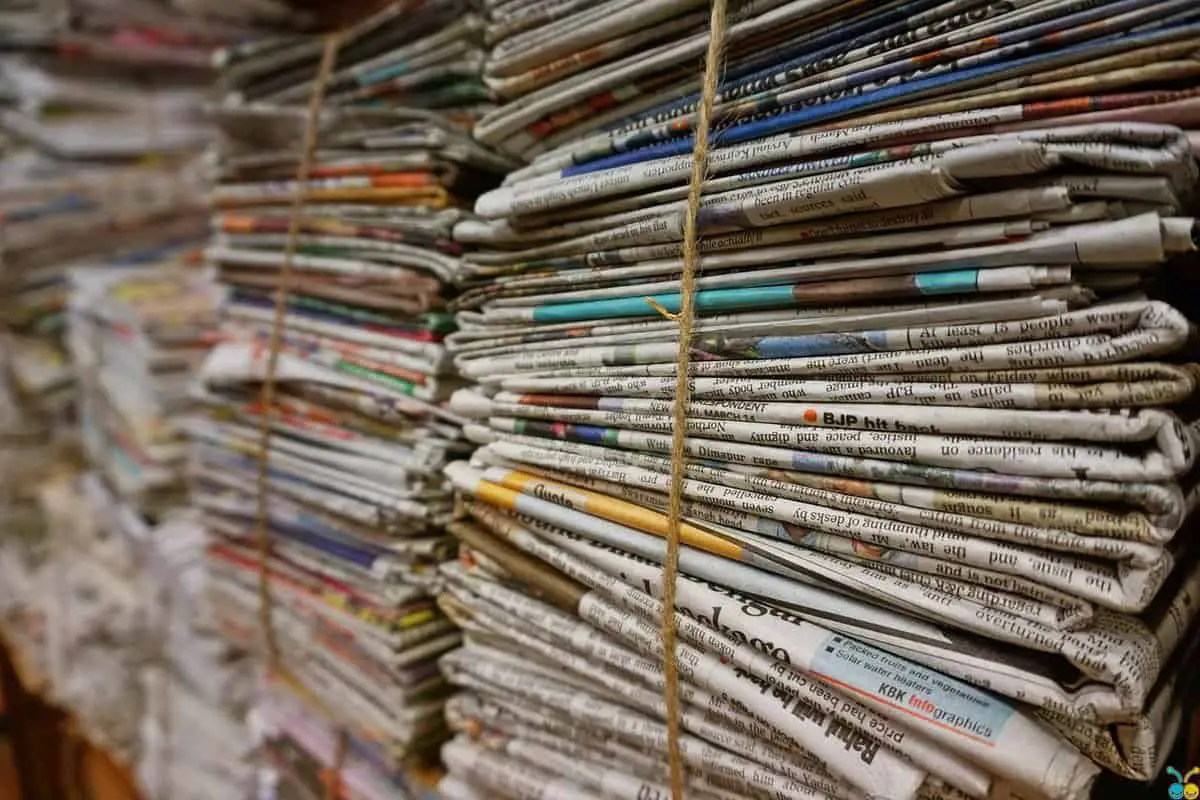
What Does Biodegradable Mean
Biodegradable materials refer to materials that can be decomposed or disintegrated into nutrient-rich soil. The decomposition process happens in the presence of natural agents such as microorganisms, water, air, and sunlight.
Biodegradable materials are non-toxic to the environment as they return to the earth at the end of their life cycle.
Non-biodegradable materials, on the other hand, refer to materials that take a long time, hundreds or thousands of years, to decompose, thus causing environmental pollution.
Is Paper Biodegradable
Paper is biodegradable as it is made from wood and other plant fibers. Since organic materials are 100% biodegradable, it is safe to say that paper is biodegradable.
Like anything else, paper takes some time before degrading completely, and paper can take anywhere from 2 to 6 weeks before it can start to decompose. On the other hand, biodegradable plastics can take years before this process even begins.
You can control the conditions in your compost bin to speed up the biodegradation process. These conditions are:
- Water
- Oxygen
- Humidity and,
- Heat
While biodegradation can still happen without these conditions, a composting system will help you regulate these conditions for faster degradation.
You can add worms and a little food waste to get even quicker results. Worms love eating biodegradable waste and can eat up to half their body weight daily. This composting facility will provide nutrient-rich soil for your garden or house plants.
Paper can quickly decompose in a compost pile at home, unlike plastics, which tend to pollute the earth. Avoid putting plastics in a compost pile, even if they are biodegradable.
It is, however, essential to note that if the paper is not disposed of properly, it can take more time to decompose and thus cause harm to the environment.
Want to find out which types of paper you can compost? This article goes on to answer that question.
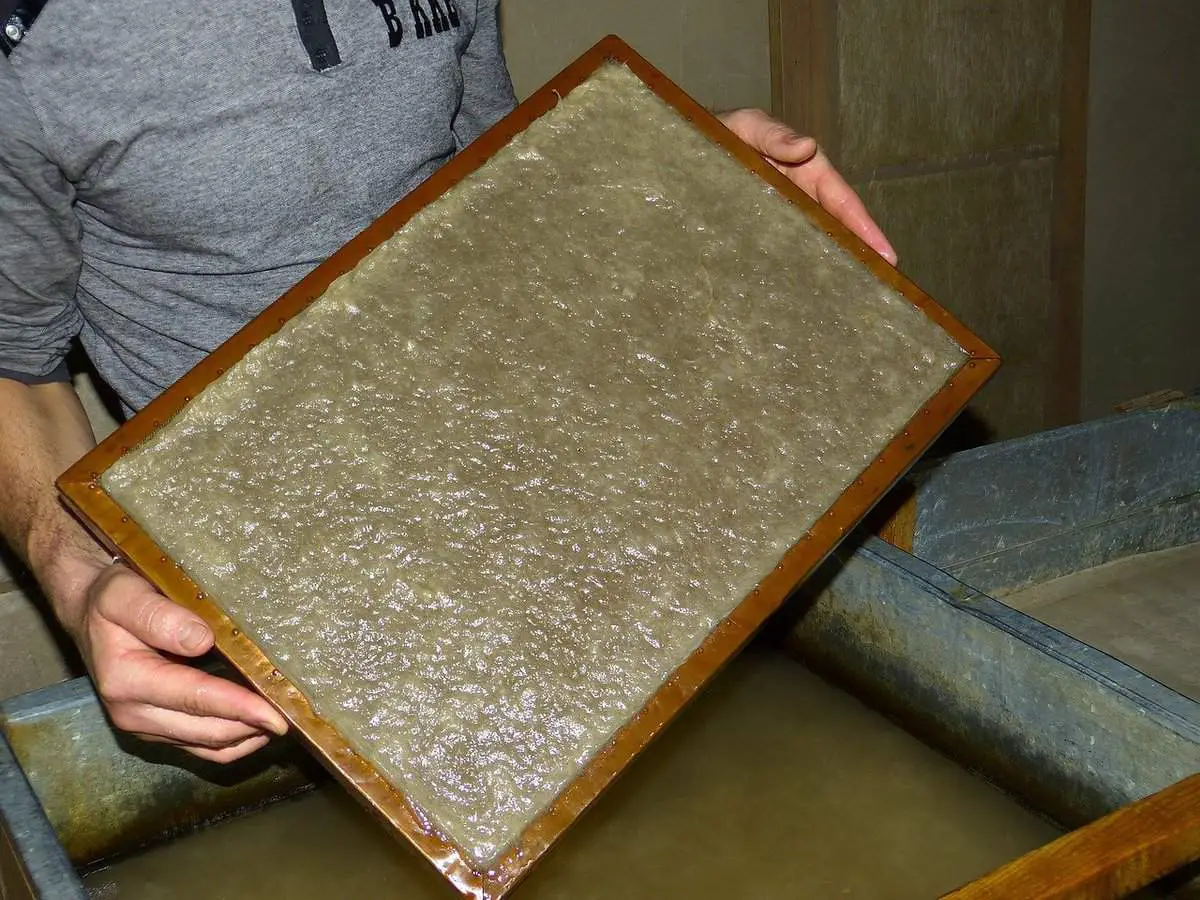
How is Paper Produced
Paper is a dry, compressed mat of plant fibers.
Paper is made from trees, mainly the softwood trees such as spruce and fir. Softwood trees are preferred because they have longer cellulose fibers in the pulp compared to hardwood trees, making the paper stronger. Paper can also be made from cotton, bamboo, flax, hemp, and other plant fibers.
While recycled materials can also make paper, more than 50% of the wood that makes piece is deliberately harvested from trees.
Here is a simple step-by-step process of paper production:
- The process begins with a machine that strips the bark of harvested trees and makes wood chips.
- Extraction of cellulose fibers from the wood chips then follows.
- Extracted cellulose is purified to remove other substances.
- The cellulose is then placed in a mixture of water and other chemical additives to produce wood pulp.
- The pulp is then squeezed and pounded thoroughly through a process called beating. The method also involves the addition of chemicals and fillers substances that influence the product’s final quality.
- Pulp is then turned into paper by passing it into a machine that filters out unwanted substances and produces a wet mat of fiber that is then dried to form a strong paper web.
- Once dried, paper is rolled and processed according to its intended use.
You can also make paper from home using the same process as industrial production.
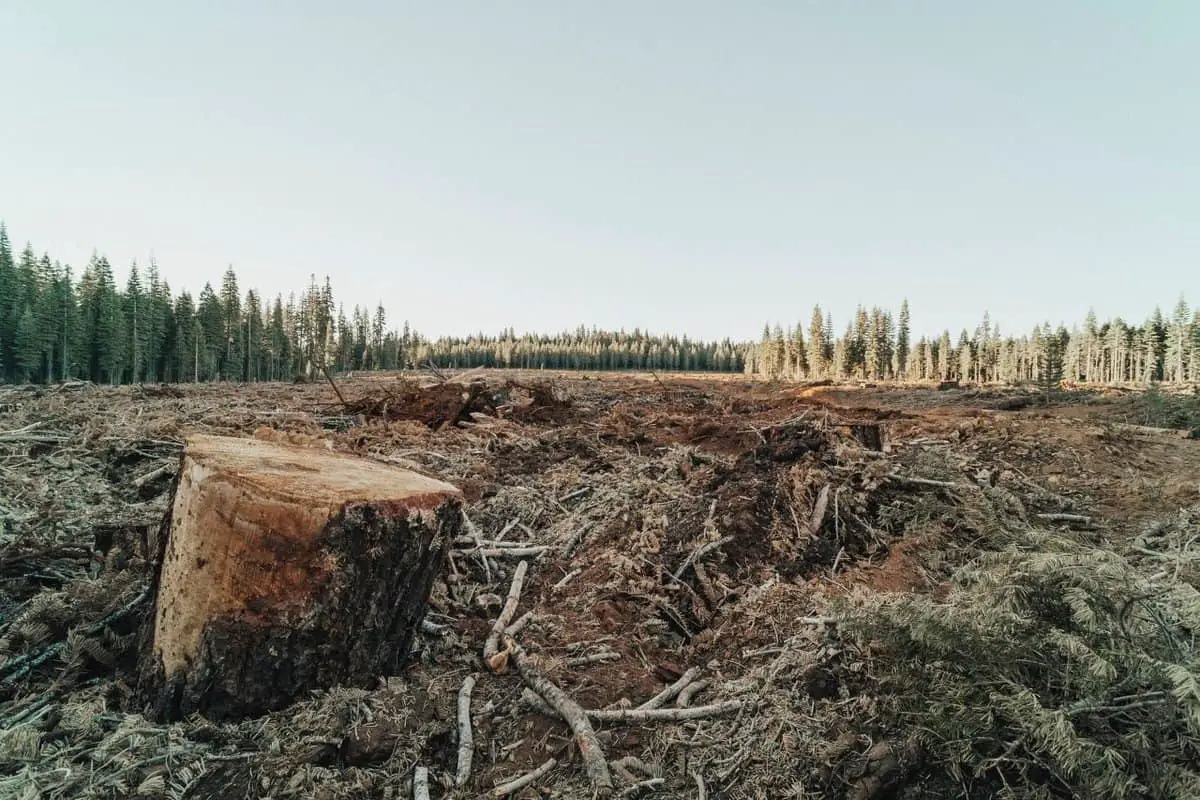
Is Paper Eco-friendly
When we say paper is biodegradable, it goes without saying that it is good for the environment. But then, biodegradability is only one aspect, and we need to look at other elements starting from the production to the end life of the paper.
Considering all factors, saying that paper is eco-friendly can be pretty tricky. Such a twist, I know.
If biodegradable plastics were appropriately disposed of, they could be more environmentally friendly than paper products.
Here is why;
Paper production comes with huge deforestation problems along its supply chain. Out of 32 million acres of forest harvested annually, 35% of that is estimated to go into paper production. That means we cut over 11 million acres of wood to use paper.
Well, trees take in carbon dioxide and give out oxygen. With increased cutting down of trees, there shall be more carbon emissions in our environment. Additionally, deforestation is responsible for the loss of wildlife habitats and biodiversity.
If you prefer to watch a detailed video about the impact of paper, be sure to check out Gittemary Johansen’s video and support her channel. She has lots of zero waste content and sustainable living tips on there.
What can we do:
Fortunately, we have options that we can opt to make paper more eco-friendly;
- Recycle Paper: Paper can be recycled up to 6 or 7 times. Recycled paper is more eco-friendly than normal paper. Recycling is less intensive and thus has a smaller carbon footprint than virgin paper production.
- Sustainable sourcing of materials: Paper processing plants must ensure that they source the materials sustainably and have certifications such as FSC certification.
- Both corporations and individuals should plant more trees to curb deforestation and climate change.
What is the Environmental Impact of Using Paper
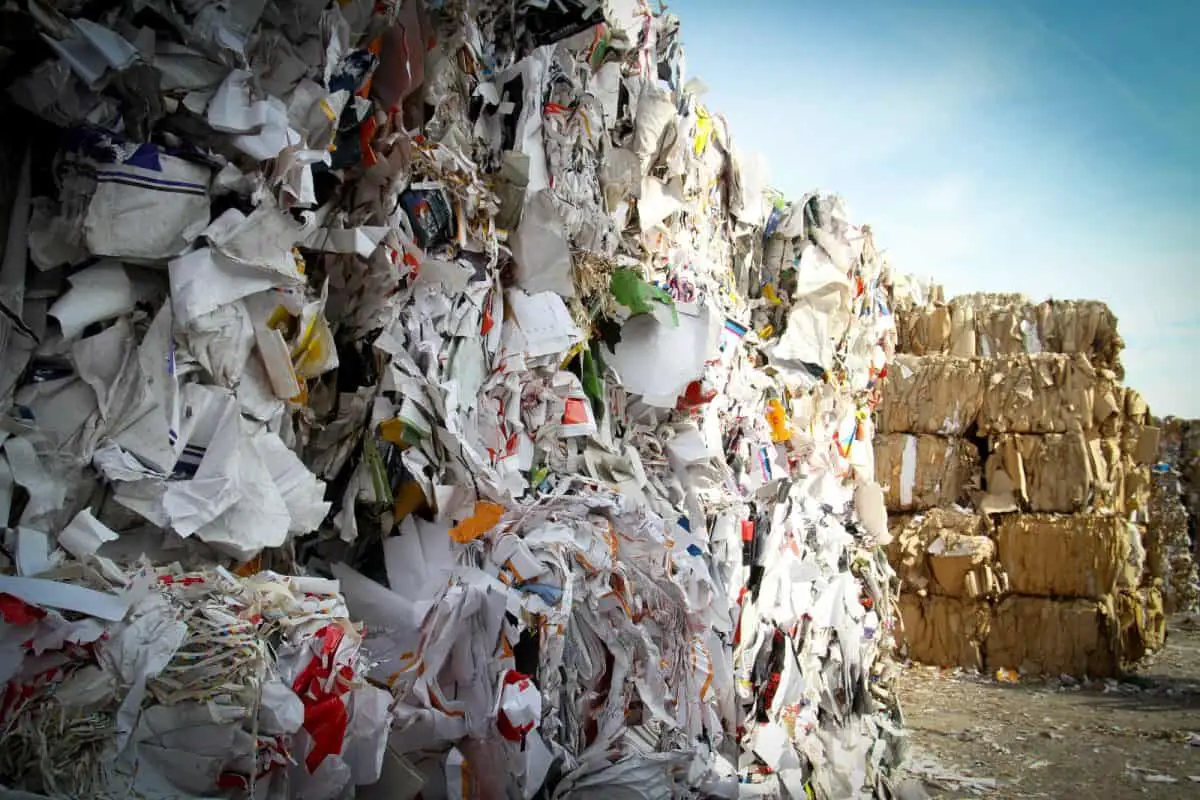
Besides the plant materials, paper processing plants use harsh chemicals to produce paper. Some of these chemicals include methanol, toluene, and formaldehyde.
Sadly, these paper mills discharge their chemical solutions into natural water resources, and EPA stated that paper mills were the largest water pollutants in the U.S.
Again a lot of water and energy are required to produce paper. Processing just one sheet of paper uses up to two liters of water! And manufacturing 1000 paper bags use 3.4 times more energy than traditional plastics.
Air pollution is another problem associated with paper production. The pulp and paper industry contributes 20% of the toxic waste in the air in the U.S.
Cardboards contribute to the most significant waste in landfills than plastics and glass combined. Greenhouse gas emissions produced from landfills are a significant cause of climate change.
What Type of Paper is Biodegradable
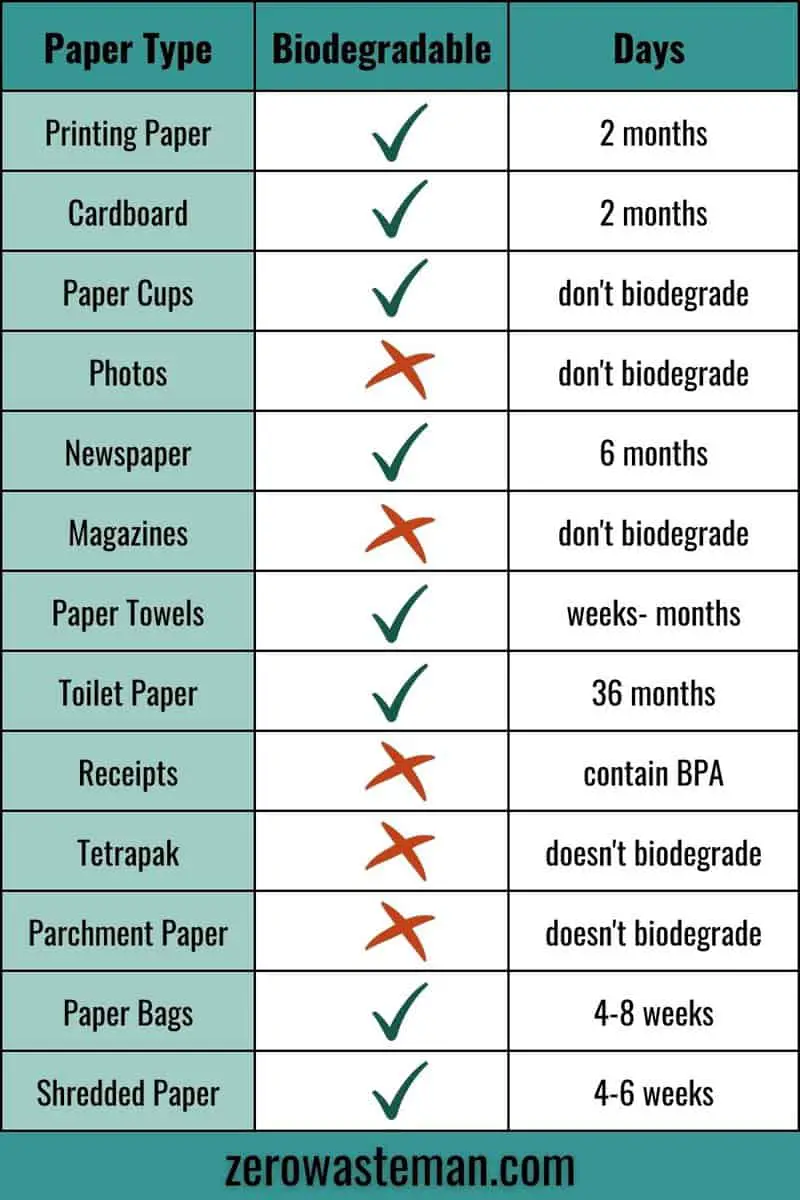
Most paper is biodegradable, thus environmentally friendly. However, depending on the production process and intended use, some paper types are non-biodegradable. Again, depending on the conditions, different papers can take more time to decompose than others.
Let’s look at different types of papers and their biodegradability.
1. Printing papers
Printing paper is biodegradable and can take around two months to decompose.
2. Cardboards
Depending on the proper environmental conditions, cardboard is biodegradable and will take around two months to decompose naturally. However, plastic or wax-coated cardboard will take much longer, even over five years.
3. Paper Cups
Though there are different paper cups, the most common ones will take one year to decompose. However, most paper cups have a plastic lining, making them unrecyclable and pretty gross to drink from.
Plastic is known to leach endocrine disrupters. I wouldn’t want that in my drink. Some of the latest paper cups use bioplastics which still require a special facility to break down into its natural components. Best to avoid paper cups. There are plenty of alternatives. Find some here.
4. Photos
Photos are not biodegradable.
5. Newspapers and Magazines
On average, newspapers and magazines will take around six months to decompose. They can be used to mulch around trees to keep the weeds off or in your garden beds. However, your glossy magazines need to go in the bin as they can be plastic-lined or have ink that is toxic to your compost pile.
6. Paper towels
Paper towels decompose quickly, but they contain chemicals and other substances that take much longer to be extracted. Also, there are many different kinds of paper towels with different strengths, which needs to be taken into account.
7. Toilet paper
Though toilet paper can be easily composted, it takes much longer, around 36 months, to completely break down. This is probably due to the septic tanks’ lack of oxygen and light.
8. Receipts
Receipts alone are responsible for 1.5 million pounds of waste in landfills. This is because, in most countries, shops must print out receipts. Unfortunately, receipts are not made of 100% paper; they contain a thin plastic lining, and this makes receipts challenging to recycle or compost. Additionally, a study found people handling lots of receipts have higher BPA count in their bloodstream. Receipts are BPA-lined.
9. Tetrapak
Milk cartons are non-biodegradable, although they can break down after a long period because they contain plastic packaging inside.
Once degraded, they will also leave microplastics behind.
10. Parchment paper
Parchment or greaseproof is neither recyclable nor compostable. This is because, although it is made of paper, it contains silicone and is also treated with other chemicals to improve its heat resistance.
11. Paper bags
Paper bags take 1-2 months to decompose completely.
12. Shredded paper
Shredding paper reduces the volume of paper waste by 50%, which is good. Shredded paper is excellent for composting or mulching, except for glossy or colored paper. You can also reuse it as packaging and pet bedding.
While shredded paper is recyclable in theory, the plant fibers are often destroyed by shredding, making it difficult to recycle.
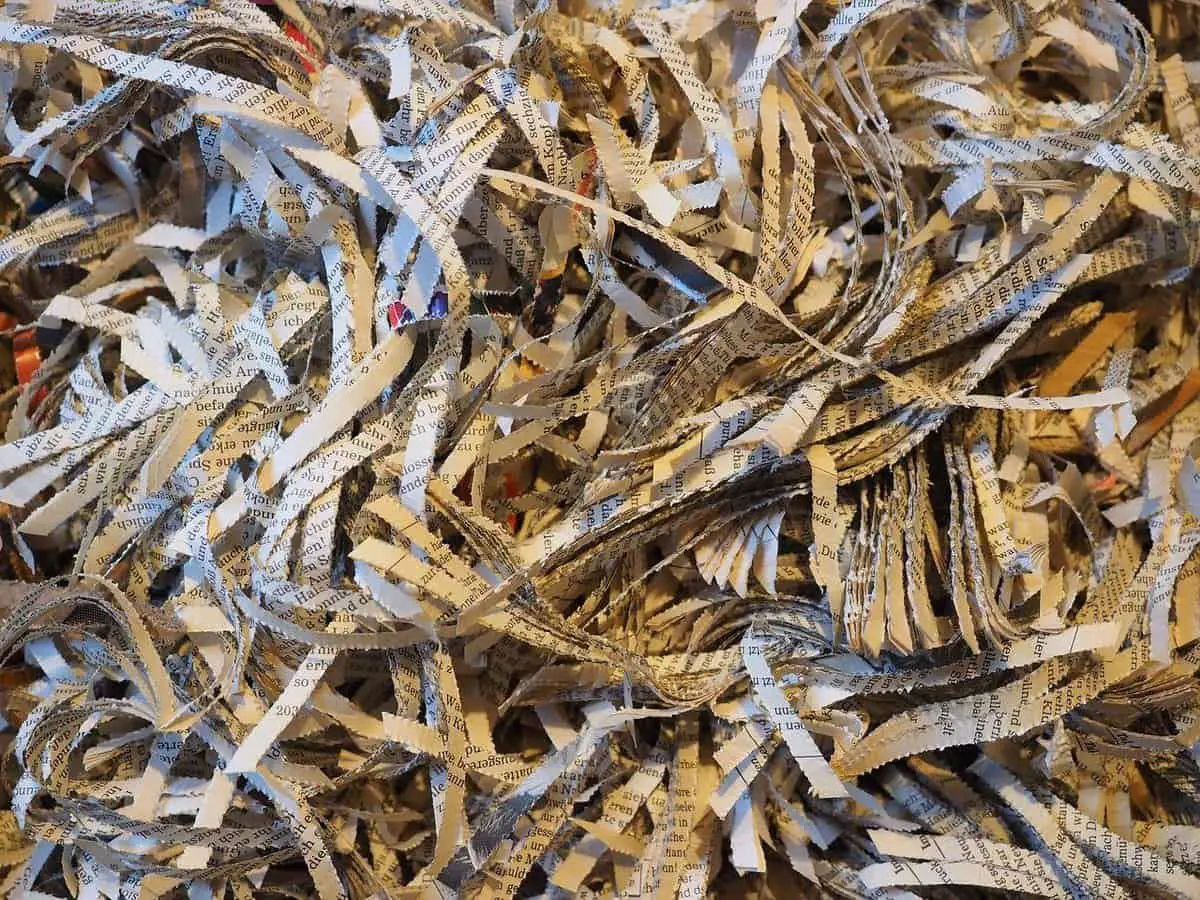
Recycle or Compost? The Best Way to Dispose of Paper Waste
Recycling and composting are better ways of disposing of paper waste than sending it to landfills. Paper in landfills takes up space and also slows the process of decomposition. Statistics show that more than 50% of landfill waste is paper and cardboard boxes.
Recycling
While recycling plants require energy and water to recycle paper, the process is still less intensive than manufacturing paper from virgin plant fibers.
When it comes to paper recycling, the first step is sorting paper into different grades depending on the quality of its raw material. The type of grade determines how easy it is to recycle paper.
Every time paper is recycled, the fibers become shorter and marred. This means that high-quality fibers can only be recycled 5-7 times. Thus, only high-quality paper, such as office printing paper, is best for recycling.
Always check first with your local authorities or recyclers to know your recycling options, as it may differ from one location to another.
Tips for Recycling Paper
Before sending your paper to the recycling bin, here is what you should do;
- Sort your paper first into clean materials and mixes.
- Remove paper clips and staplers- though most recycling companies have machines that can do that, you can always reuse the clips.
- Cut out greasy parts of paper that have been in touch with food, e.g., pizza boxes.
- Since wet paper is unrecyclable, dry it in a window cill or laundry line before sending it to the recycle bin.
- Check if the paper has a plastic lining, especially for food-related packaging like coffee cups, and whenever possible, remove the plastic.
- Pro-tip; to remove the plastic lining, wet a corner of the paper, and you will easily peel out the plastic.
Always recycle as much as possible, whether it’s compostable plastics or paper waste.
Composting
Composting is an excellent way to avoid sending unrecyclable paper types to landfills. The best paper for composting includes;
- Paper made of low-quality fibers such as tissue paper, napkins, and newspapers
- Paper that has been contaminated with human waste and greasy foods
While composting is a good option, it shouldn’t replace recycling. Composting higher-grade paper could increase the demand for virgin plant fibers, resulting in increased deforestation.
Home composting is one way we can help reduce the greenhouse gas emissions produced at landfills.
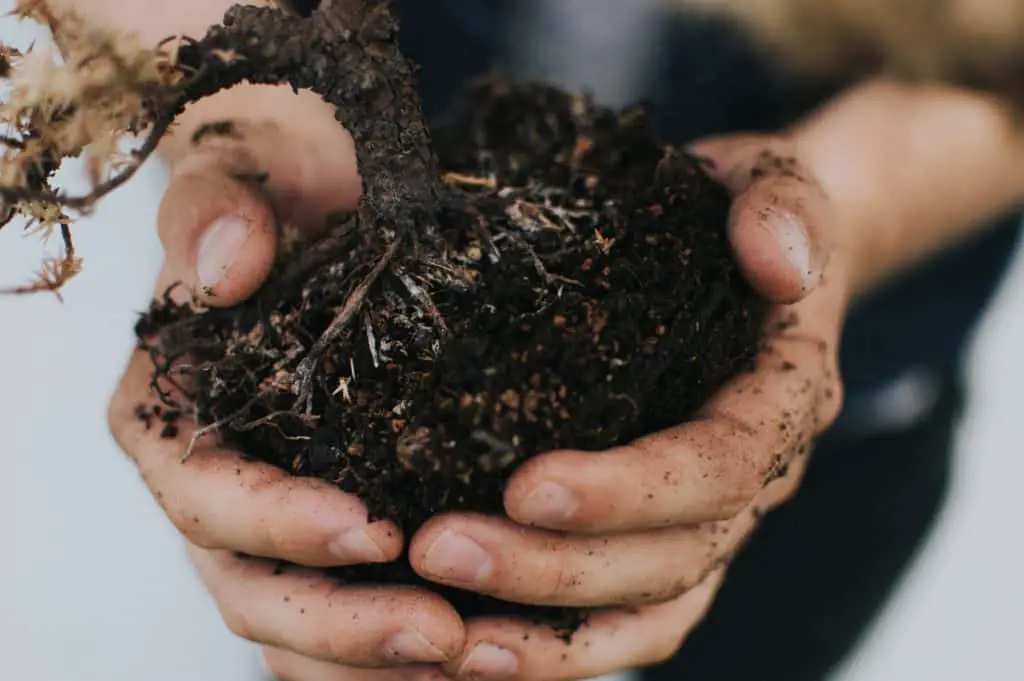
Composting at Home
You need to know a few points before considering composting paper at home.
First, paper cannot be composted with other materials in the same bin, and this means you will require a separate and proper bin for paper composting.
Secondly, ensure to carry out the composting with care to avoid bad smells.
Also, When adding more paper, always put the dry leaves before they get wet.
If done correctly, you should have your manure in 40 days, which you can use in your garden.
Paper Vs. Plastic: Which is Better
As we mentioned above, most type of paper is biodegradable and easily recyclable. One downside of paper, however, is the reduced number of reuses, especially when it gets wet.
Plastics are convenient, easy to use, and readily available.
Although we cannot ignore the downsides of paper, plastics are more harmful and dangerous to the environment. First, they take thousands of years to degrade. Secondly, most plastics are not easily recyclable, posing more environmental threats.
Although home compostable plastics are on the rise, very few households compost. Again, biodegradable plastics tend to compose only in proper conditions, i.e., they cannot degrade in water.
I think a naturally biodegradable product is better than one that lingers in microplastics.
Conclusion
I hope this post has given you some insight into how to tell whether paper is biodegradable or not.
Paper is biodegradable as long as it isn’t lined with plastic packaging. Paper can also be easily recycled several times. For unrecyclable paper, consider composting at home.
What other ideas for eliminating paper waste at your home or office do you know?
